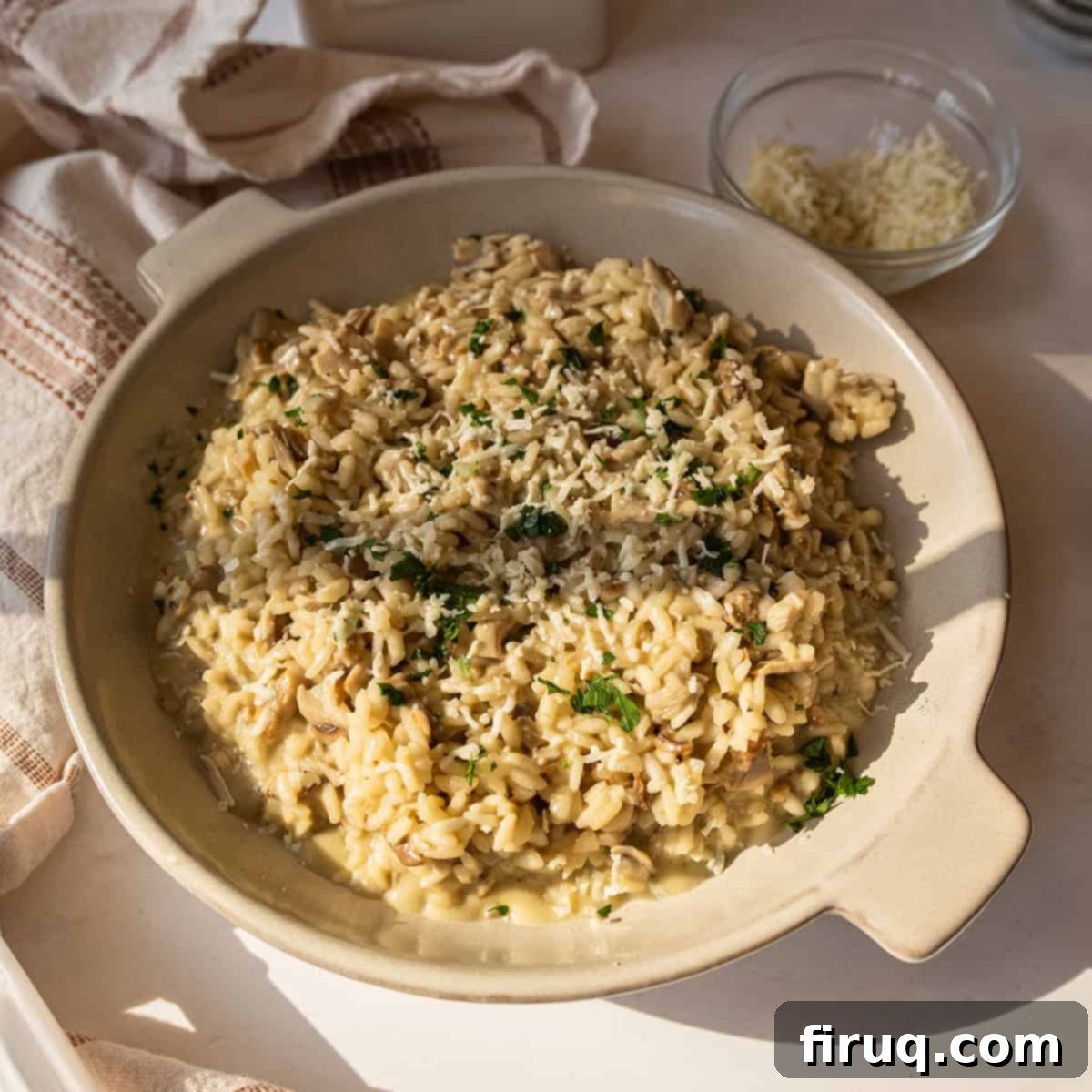Decadent Gorgonzola Risotto with Mushrooms: A Creamy, Flavorful Twist on Classic Italian Comfort
Prepare your palate for an extraordinary culinary experience with this creamy and delightfully bold Gorgonzola Risotto with Mushrooms. Infused with a rich, robust flavor that truly melts in your mouth, this dish offers a sophisticated yet comforting twist on traditional risotto. Its unique and distinct character makes it a perfect companion for elegant mains such as Crispy Italian Chicken Cutlets or tender Cast Iron Boneless Pork Chops, elevating any meal into a gourmet affair.

Beyond this spectacular risotto, if you’re exploring options for more delectable accompaniments, consider our enticing Rice Dressing with Sausage and the irresistibly crunchy Crispy Garlic Parmesan Potatoes. Each offers a unique flavor profile to complement any meal.
[feast_advanced_jump_to]
Elevating Risotto: The Magic of Gorgonzola Cheese
Forget everything you thought you knew about classic risotto; we’re taking a flavorful detour into what I affectionately call “Funkytown” with this one. Our Gorgonzola risotto, perfectly paired with delicious Italian oyster mushrooms, delivers an incredibly creamy texture and a truly distinct flavor profile. My culinary journey has always been driven by a passion for experimentation, especially when it comes to reinventing classic dishes. Switching up the cheese in a risotto is one of my favorite ways to unlock new dimensions of taste and texture.
While a traditional risotto, like our popular Zucchini Risotto, offers a familiar and comforting taste, for those yearning for something truly different and exciting, gorgonzola is your answer. Its pungent, yet surprisingly sweet and creamy notes create a depth of flavor that is simply unparalleled. On a recent visit to the Farmer’s Market, I discovered these exquisite Italian Oyster Mushrooms, which introduced a subtle hint of licorice and earthy undertones, perfectly complementing the bold cheese.
You’ll be genuinely surprised by how much you adore this unconventional pairing. My background, having owned a catering company specialized in cured meats and cheeses, fostered an adventurous spirit for exploring diverse flavors. This very spirit is what led to innovative creations like our Goat Cheese Burger with Fig Jam recipe, proving that a daring combination of ingredients can lead to truly memorable dishes.
Ingredient Notes and Expert Substitutions for Your Risotto
Choosing the right ingredients is paramount to the success of any risotto, especially one as distinct as our Gorgonzola and Mushroom variant. Here’s a breakdown of what you’ll need and how to make thoughtful substitutions:
- Gorgonzola: This is the star of our dish. While you could technically substitute Parmigiana for a more traditional risotto, as seen in our Creamy Cherry Tomato Risotto, it simply won’t yield the same “funky” and uniquely creamy flavor that gorgonzola provides. Gorgonzola, particularly the “Dolce” (sweet) variety, melts beautifully, creating an unparalleled lusciousness. The “Piccante” (sharp) type would offer a bolder, more intense flavor.
- Arborio Rice: My go-to for risotto, Arborio rice is widely available and performs wonderfully due to its high starch content, which is crucial for achieving that signature creamy texture. However, for an even creamier result, you could opt for Carnaroli rice, often considered the “king of risotto rice” for its superior starch retention and firm texture. Other suitable options include Baldo or Padano rice. Remember, never rinse your risotto rice; the starch is exactly what we want!
- Italian Oyster Mushrooms: These mushrooms are a fantastic find, offering a delicate anise-like aroma and a robust earthy flavor. If you can’t locate them, standard baby bella mushrooms (cremini) are an excellent substitute. They provide a satisfying meaty texture and a deep umami flavor, though without the subtle licorice notes of the Italian oyster variety. Shiitake or portobello mushrooms could also be used for a stronger mushroom presence.
- Shallots: I prefer shallots for their milder, more delicate onion flavor with a hint of garlic, which doesn’t overpower the gorgonzola. If shallots are unavailable, yellow onion can be used, but note that its flavor will be stronger. Red onion could also work, adding a slightly sharper, peppery note.
- White Wine: Sauvignon Blanc is my top choice for cooking with white wine in this risotto. Its crisp, dry, and sometimes herbaceous notes beautifully deglaze the pan and add a bright acidity that cuts through the richness of the cheese. Dry Vermouth is an excellent non-alcoholic alternative, or you could opt for another dry white wine like Pinot Grigio or un-oaked Chardonnay. Avoid sweet wines, as they will alter the dish’s balance.
- Chicken Broth: This forms the liquid base of our risotto. I highly recommend using a low-sodium chicken broth to control the overall saltiness of the dish, allowing the gorgonzola to truly shine. Vegetable broth is a perfectly acceptable substitute for a vegetarian version, or for those preferring a lighter flavor profile. Always ensure your broth is warm when adding it to the rice; this prevents cooling down the risotto and maintains a consistent cooking temperature, crucial for even absorption.
*Please see the recipe card below for precise measurements and additional information on the ingredients.
Mastering the Art: How to Make Creamy Gorgonzola Risotto with Mushrooms
Making risotto is often perceived as an intimidating task, but with a few key principles and a bit of patience, you can achieve a perfectly creamy and rich dish every time. Trust me, I’ve had my share of less-than-perfect risottos on this learning curve, but these two pieces of advice, born from my biggest mistakes, will set you up for success:
- The Golden Rule: Never Abandon Your Risotto! Okay, it’s fine to step away for a mere minute or two, but seriously, the rice can quickly stick to the bottom of the pan and scorch. This inevitably ruins the entire dish, imparting an unpleasant burned flavor. Constant, gentle stirring is essential not only to prevent sticking but also to encourage the starches to release, creating that desired creamy texture.
- Achieving “All’onda”: Add Cheese and Butter While Still Liquid. The secret to a luscious, flowing risotto (known as “all’onda,” or “wavy” in Italian) lies in the final stage. You need to incorporate the cheese and butter while the rice is still slightly loose and has a bit of liquid remaining. If you wait until the rice is completely dry, it becomes much harder to achieve that beautiful, velvety consistency that gently spreads when you move the pan. This step, often called “mantecatura,” is where the magic happens, emulsifying the fats and starches for ultimate creaminess.
Just follow along with the numbered steps below, which correspond to the accompanying pictures, and you’ll create a truly delicious and impressive risotto.
Step 1: Begin by adding the chicken broth to a small pot and place it over medium-low heat. It’s crucial for the broth to be hot when you add it to the rice; this ensures continuous cooking and prevents the temperature of the risotto from dropping.
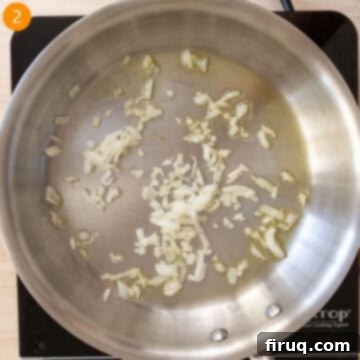
Step 2: In a large, heavy-bottomed saucepan, heat olive oil over medium heat. Once shimmering, add the chopped shallots and sauté for 2-3 minutes, stirring occasionally, until they become translucent and soft, releasing their mild aromatic flavor.
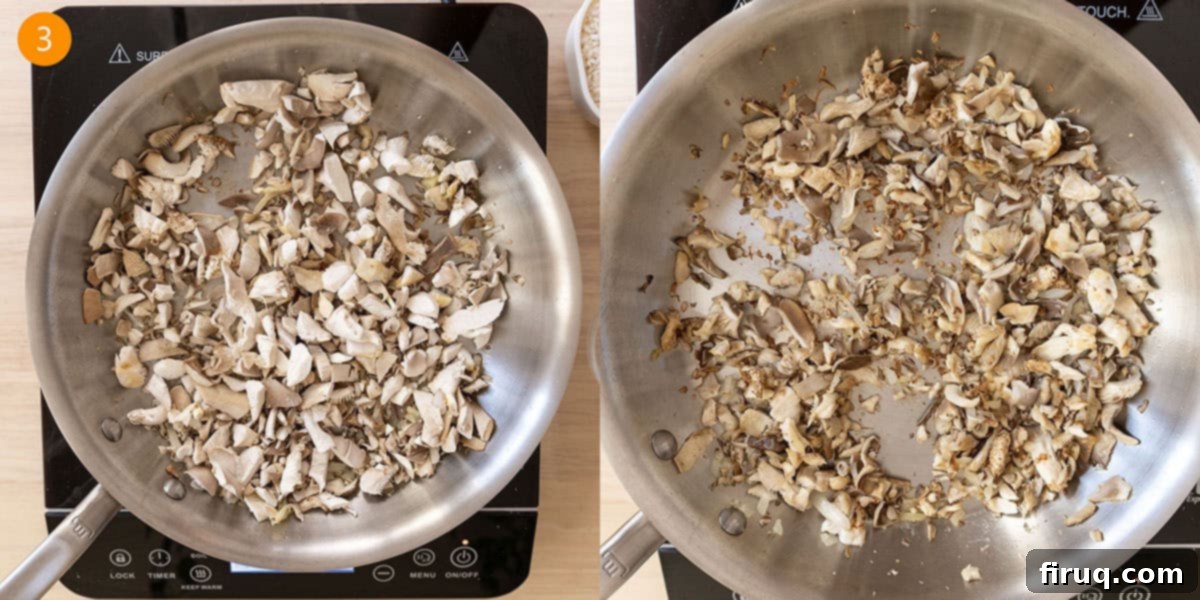
Step 3: Now, stir in the chopped mushrooms. Continue to sauté the mushrooms and shallots patiently until the mushrooms release all their moisture, then begin to brown and develop a deep brown color. This browning process is essential for building deep umami flavor. As the mushrooms shrink and start to brown, they will intensify their earthy notes. This step will typically take about 8 minutes, possibly longer depending on the mushroom type and quantity.
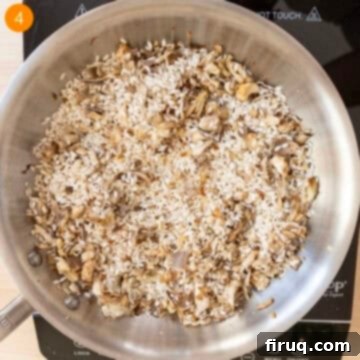
Step 4: Add the Arborio rice to the pan. Stir it vigorously with the mushrooms and shallots to toast the rice for 2-3 minutes. This “toasting” step, known as *tostatura*, seals the exterior of the grains, allowing them to slowly release starch later for creaminess while maintaining a slight bite. You should observe a small opaque circle appearing on the outside of each rice grain as it toasts.
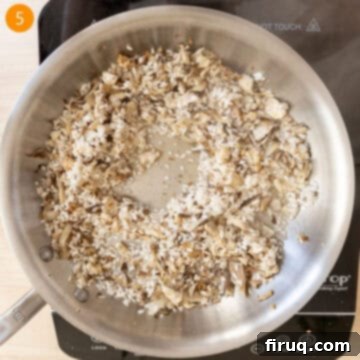
Step 5: Carefully pour in the white wine and bring the mixture to a gentle simmer. Simmer the wine, stirring occasionally, until the rice has completely absorbed all the liquid. This deglazing step adds a layer of bright acidity and helps to scrape up any flavorful browned bits from the bottom of the pan.
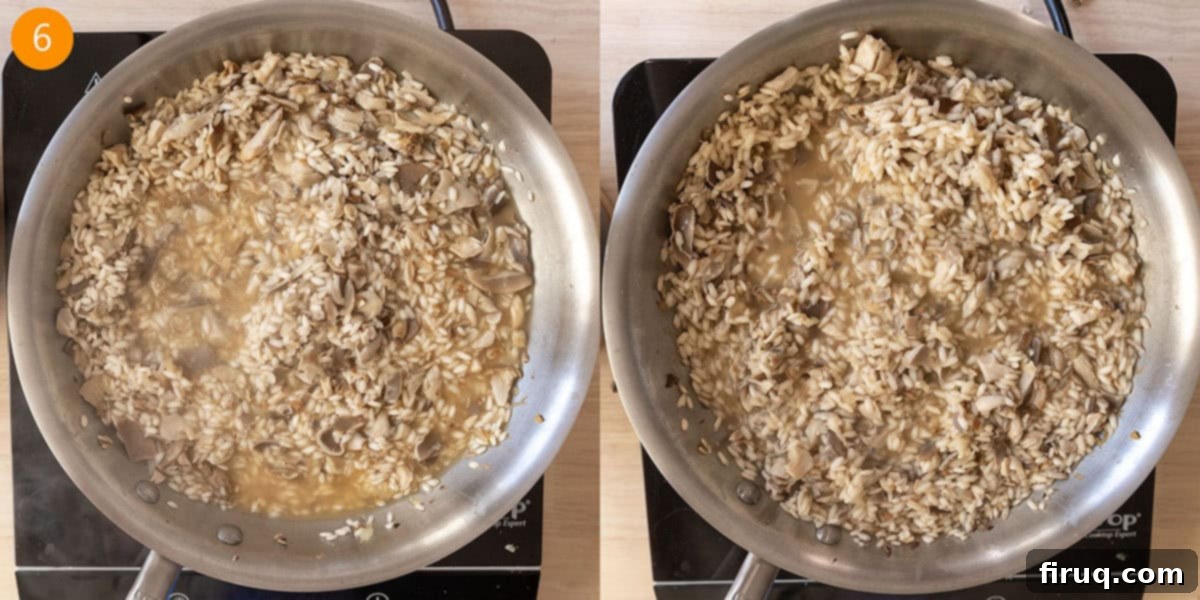
Step 6: Now for the heart of risotto making: slowly add ladlefuls of the warm chicken broth, one at a time, allowing each addition to be almost completely absorbed by the rice before adding the next. This gradual process, combined with frequent stirring, is what encourages the rice to release its starches and achieve its characteristic creaminess. Stir often to prevent the rice from sticking to the bottom of the pan and ensure even cooking. This entire process will take approximately 18-20 minutes. Around this time, you should have less than 1 cup of broth remaining. Taste the rice – primarily for texture rather than flavor at this stage. If it still has a discernible crunch in the center, add another ladleful of chicken broth and continue cooking until it’s al dente (tender with a slight resistance). We are aiming for a soft yet structured grain.
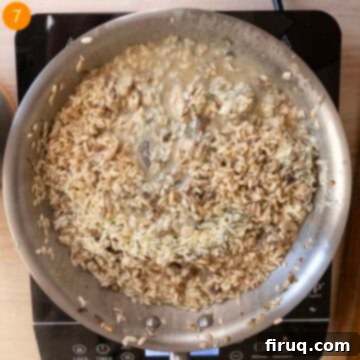
Step 7: As the rice absorbs its final ladleful of chicken broth and reaches the desired al dente texture, prepare to add the gorgonzola and butter. This is a critical moment for *mantecatura* (the emulsification and creaming step). You should add these rich ingredients while the rice is still slightly loose and moist, allowing them to melt and blend seamlessly into the risotto.
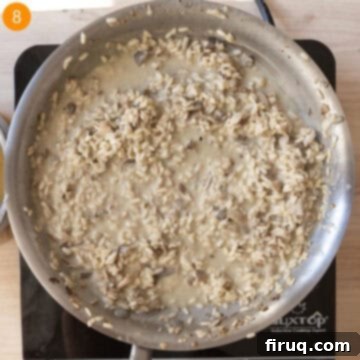
Step 8: Crucially, remove the pan from the heat immediately. Add the gorgonzola and butter directly into the risotto. Vigorously toss and stir the rice with the cheese and butter until they have completely melted and are fully incorporated into the rice. This process creates that glorious, creamy, and unctuous texture. Season generously with salt and freshly ground black pepper to taste, adjusting as needed to balance the flavors.
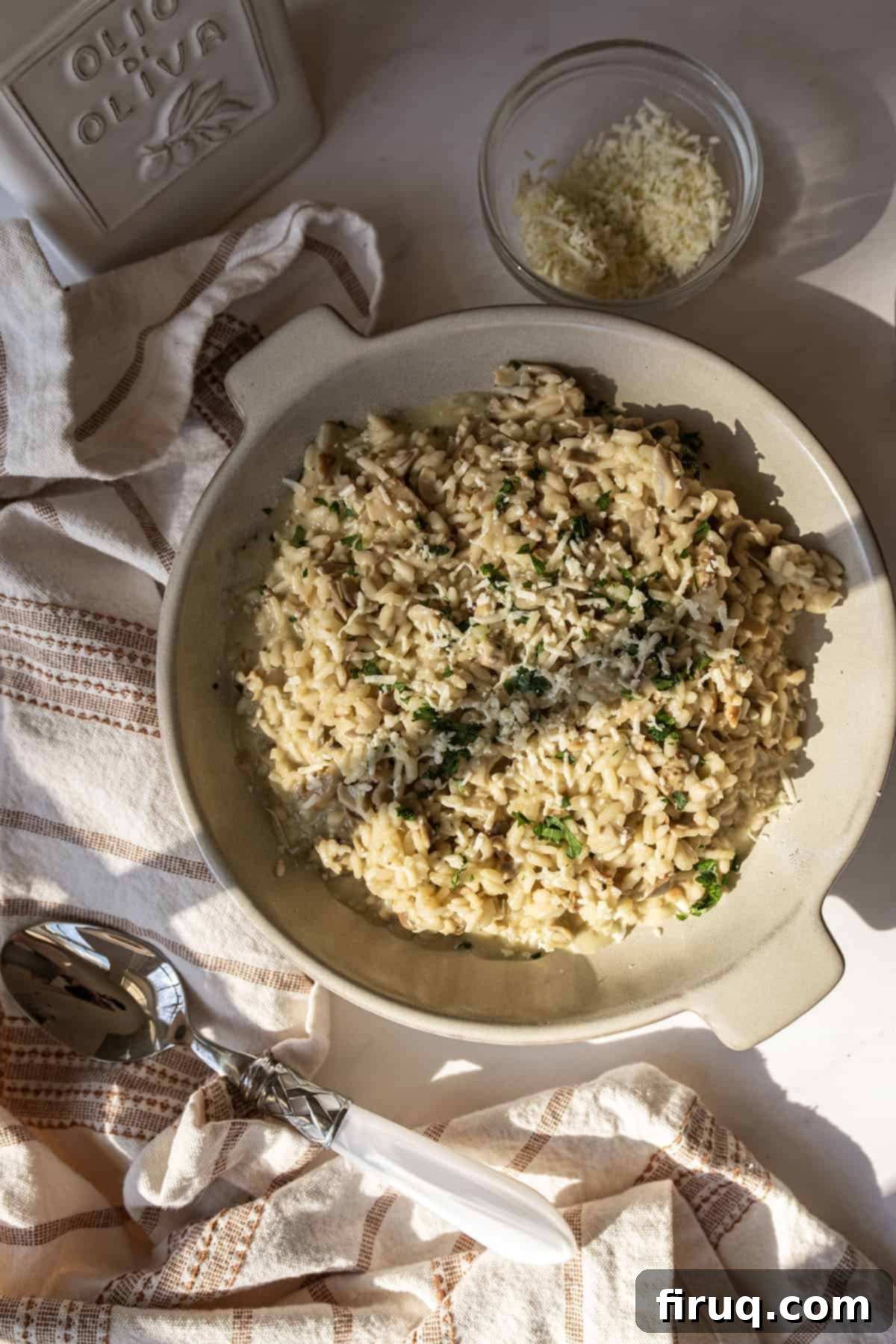
Serve your magnificent risotto immediately on warm plates. The rice should still be somewhat loose enough to slowly spread across the plate, demonstrating that desired “all’onda” consistency. If it appears too stiff, don’t fret; simply stir in a tiny bit more warm chicken broth until it reaches the perfect flowing consistency.
This Gorgonzola Risotto with Mushrooms, with its complex and rich flavor profile, shines brightest when paired with simple, well-prepared proteins. Consider serving it alongside our tender Cast Iron Chicken Breast or a classic Pork Chop Milanese. The understated elegance of these dishes allows the risotto to take center stage, creating a harmonious balance where the flavors complement rather than compete. Overly fancy or heavily sauced proteins might clash with the bold, unique character of this creamy gorgonzola masterpiece.
Pro-Tips for Your Best Risotto Yet
Achieving risotto perfection is a journey, but these professional tips will guide you to a truly exceptional outcome:
- Mastering Mushroom Sauté: Mushrooms are packed with moisture. When you sauté them, resist the urge to stir constantly at first. Let them sit a while undisturbed in the hot pan to release their liquid. Once the liquid evaporates, they will begin to brown beautifully, developing deep, concentrated flavors. Only then should you stir often to brown them evenly and prevent the delicate shallots from burning. This browning step is crucial for the umami base.
- Always Use Hot Broth: This is a non-negotiable step for authentic risotto. Employing hot chicken broth ensures that the rice continues to cook consistently without interruption. Adding cold broth would repeatedly drop the temperature of the risotto, making the cooking process slower and resulting in a less creamy, less uniformly cooked dish. Keep your broth simmering gently in a separate pot throughout the entire process.
- Fine Grate Your Gorgonzola: For the smoothest, most effortlessly creamy risotto, grate your gorgonzola on the smallest possible hole of your grater. Smaller pieces melt much faster and more evenly into the rice, greatly reducing the likelihood of clumps and ensuring a velvety texture throughout.
- Mantecatura Off the Heat: The final addition of cheese and butter (mantecatura) should always be done off the heat. If the cheese gets too hot, the proteins can seize and separate, leading to an oily or grainy texture rather than the desired emulsified creaminess. Removing from heat allows the residual warmth of the risotto to gently melt the cheese and butter into a smooth, luscious sauce.
- Trust Your Taste Buds, Not Just the Clock: While timings are a guide, every batch of rice and stove will be slightly different. The most important tip is to taste the rice frequently towards the end of cooking. You’re looking for that perfect al dente texture—tender yet with a slight, pleasant resistance at its core. If it’s too crunchy, add more liquid; if it’s too soft, you’ve overcooked it slightly (but it will still be delicious!).
Recipe FAQs: Your Questions Answered
While all gorgonzola is a type of blue cheese, not all blue cheeses are gorgonzola. Gorgonzola is a specific Italian blue cheese, originating from the town of Gorgonzola near Milan. It’s known for its distinctive green-blue marbling and generally has a milder, sweeter, and creamier profile compared to many other blue cheeses like Roquefort or Stilton, which can be sharper and more crumbly. There are two main varieties: Gorgonzola Dolce (sweeter, softer) and Gorgonzola Piccante (firmer, sharper).
Gorgonzola is incredibly versatile and pairs beautifully with a range of flavors. For wines, I love a crisp Sauvignon Blanc or a dry Chardonnay that can cut through its richness. Alternatively, a robust Cabernet Sauvignon or a full-bodied red like Barolo can stand up to its bold character. In terms of food, gorgonzola shines with sweet elements like figs, pears, honey, and walnuts. It’s also fantastic with rich, savory items such as prosciutto, steak, and, as in this recipe, earthy mushrooms. Its creamy texture makes it perfect for melting into sauces or spreading on crusty bread.
Absolutely! While not strictly “necessary” for the rice to cook, adding a generous knob of cold butter at the very end (during the mantecatura stage) is a classic Italian technique that significantly enhances risotto. It contributes immensely to the richness, gloss, and velvety creaminess, creating that signature “all’onda” consistency. Cold butter, when stirred into the hot risotto off the heat, emulsifies with the starches, preventing oil separation and delivering a luxurious finish, especially if you’re not serving it immediately.
Risotto is best enjoyed fresh, immediately after it’s made, to appreciate its creamy texture and al dente rice. The rice continues to absorb liquid and will lose its desired consistency if left to sit. However, you can prepare the *soffritto* (sautéed shallots and mushrooms) and toast the rice ahead of time. When ready to serve, simply reheat the toasted rice mixture, deglaze with wine, and then gradually add hot broth, finishing with gorgonzola and butter as usual. Leftovers can be stored in an airtight container in the refrigerator for 1-2 days and gently reheated with a splash of broth or water, though the texture won’t be quite the same as fresh.
Discover More Delicious Side Dishes from Our Kitchen
Looking to diversify your meal planning? Explore these other fantastic side dishes from our collection, each offering unique flavors and textures to complement your main courses:
- Pasta alla Norma (A Sicilian Dish)
- Italian Lentils
- Sautéed Rapini with Garlic
- Summer Farro Salad with Cannellini Beans
If you’ve enjoyed crafting this Gorgonzola Risotto, we’d love to hear from you! Please leave a comment and a star rating below in the recipe card to share your thoughts. Don’t hesitate to tag us on Instagram @vindelgiudice when you share your delicious creations!
📖 Recipe
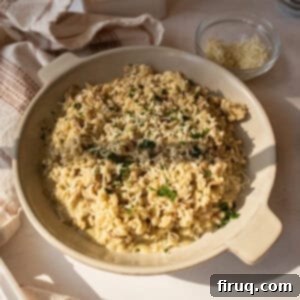
Gorgonzola Risotto with Mushrooms
Vincent DelGiudice
Pin Recipe
Equipment
-
1 large saucepan
-
1 cheese grater
-
1 small pot
Ingredients
- 1.5 cups arborio rice
- 8 oz gorgonzola, finely grated
- 2 shallots, finely chopped
- 10 oz baby bella mushrooms, roughly chopped
- ½ cup dry white wine (e.g., Sauvignon Blanc or Pinot Grigio)
- 4-5 cups low-sodium chicken broth, warmed
- ½ teaspoon salt
- ½ teaspoon black pepper, freshly ground
- 2 tablespoon olive oil
- 2-3 tablespoon fresh parsley, chopped (for garnish)
- 3 tablespoon cold butter, cut into cubes
Instructions
-
In a small pot, gently heat the chicken broth over medium-low heat. Keep it warm throughout the risotto cooking process.
-
In a large, heavy-bottomed saucepan, add olive oil and heat over medium flame. Once hot, add the chopped shallots and sauté for 2-3 minutes until they soften and become translucent. Next, stir in the chopped mushrooms. Continue to sauté the mushrooms and shallots, allowing the mushrooms to release their liquid and then brown deeply, which usually takes about 8 minutes.
-
Add the Arborio rice to the pan with the mushrooms and shallots. Stir continuously for 2-3 minutes to toast the rice grains. You should observe a small opaque circle forming on the outside of each rice grain.
-
Pour in the white wine and bring it to a simmer, stirring gently. Simmer until the rice has completely absorbed all the wine.
-
Begin adding the warm chicken broth, one ladleful at a time, to the rice. Stir frequently, allowing each addition of broth to be almost completely absorbed before adding the next. This process typically takes about 18-20 minutes. As you approach the 18-minute mark, there should be about 1 cup of broth remaining. Taste the rice for texture; if it still has a crunch, add another ladleful of broth and continue cooking until it’s tender but still firm to the bite (al dente).
-
Remove the pan from the heat. While the risotto is still slightly loose and moist, add the finely grated gorgonzola and the cold butter cubes. Toss and stir vigorously until the cheese and butter have completely melted into the rice, creating a rich, creamy, and velvety texture. Season with salt and freshly ground black pepper to taste.
-
Serve immediately on warm plates. The risotto should have an “all’onda” consistency – loose enough to gently spread across the plate. If it appears too thick, stir in a tiny splash more warm chicken broth until the desired consistency is achieved. Garnish with fresh parsley.
Notes
- Mushrooms contain a lot of water. When sautéing, allow them to sit and release their liquid before stirring constantly to achieve a deep brown color and rich flavor. This also prevents shallots from burning.
- Always use hot chicken broth when making risotto. This maintains a consistent cooking temperature for the rice, ensuring faster absorption and a more evenly creamy result.
- For the smoothest risotto, grate the gorgonzola on the smallest holes of your grater. This helps it melt quickly and seamlessly, preventing clumps.
- The final addition of cheese and butter should always be done off the heat. This prevents the cheese proteins from overcooking and becoming grainy, ensuring a luscious, emulsified texture.
- Taste for doneness frequently at the end. You’re looking for an al dente rice: tender with a slight, pleasant chew in the center.
Nutrition
